Seattle was beautiful and I cannot wait to show you pictures, but first, there’s a salad I’ve been meaning to tell you about – it’s called fattoush (فتوش).
It seems like the market for Middle Eastern salads (outside of the Middle East) is disproportionally dominated by tabbouleh, a salad, that when made right, combines ultra-finely chopped parsley with tiny pearls of fine-ground bulger wheat and other finely chopped vegetables. Fattoush is quite the opposite, at least when it comes to preparation – it can be thrown together in a matter of minutes, in a very rustic and hearty way that’s all about flavor rather than embellishments. Tabbouleh is delicious though, don’t get me wrong. Sometimes, however, I just want a quick and tasty, no-frill salad, and for moments like these I make fattoush.
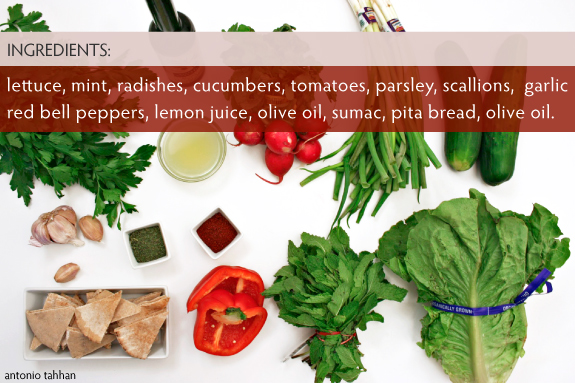
The mise en place can be overwhelming, but in one trip to the farmer’s market you can have all these vegetables laid out on your table, too. The most exotic ingredient here is probably the sumac, which is a lemony, sour spice that can be found in most specialty markets these days and certainly any Mediterranean market you know of. If you like cooking Middle Eastern dishes, this is a spice that you should always have on hand.
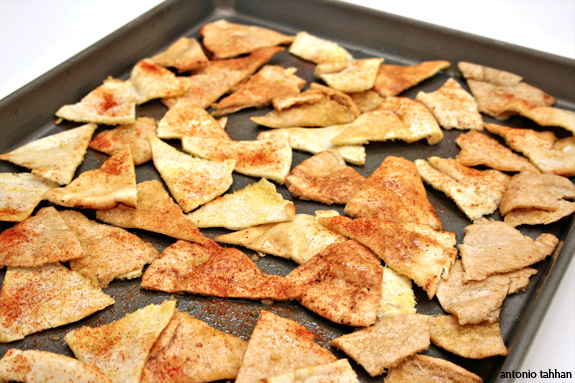
This is the part where some people might disagree: the bread. Probably the best (and most traditional) way you can prepare the bread for fattoush is by pan-frying the triangles in extra virgin olive oil, but that takes a long time and makes a mess of my stovetop. I prefer to toss the pita triangles in olive oil, sprinkle some sumac on the bread (something my grandmother taught me), and throw the whole tray into the oven/broiler, on high.
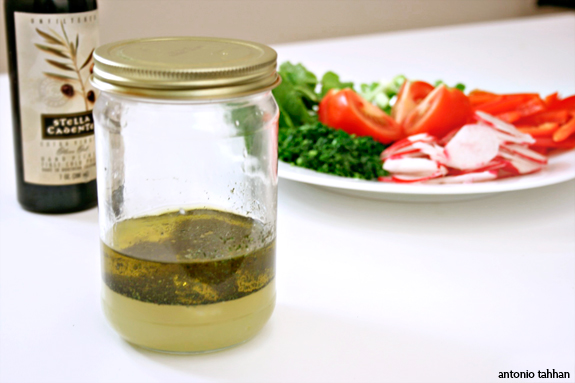
The dressing for this salad is equally simple, as promised. It’s a combination of olive oil and lemon juice, with a sprinkle of salt and sumac – that’s it. You can add dried mint to the dressing like I did, but that’s completely up to you.
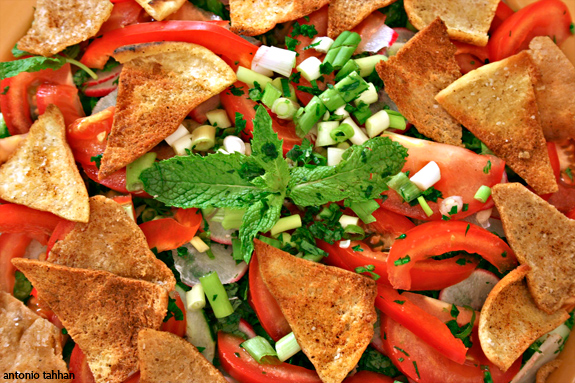
Fattoush
for the salad
Components
-
- 1 head romaine lettuce
- 2-3 medium tomatoes
- 1 bunch of scallions, chopped
- 1/3 cup radishes, sliced
- 1/2 cup cucumbers, chopped
- 1/2 cup red bell peppers, chopped
- 1/3 cup mint, chopped
- 1/2 tsp sumac
- 1-2 cloves of garlic, finely chopped
- 2-3 pita breads, cut into triangles
- 1/4 cup olive oil
- salt, to taste
dressing/vinaigrette
- 2 parts extra virgin olive oil
- 1 part lemon juice
- 1 tsp sumac
- sprinkle of dried mint, optional
- salt, to taste
Putting them all together
- Roughly chop all your vegetables, except the radishes, I prefer to slice those.
- Chop the pita bread into triangles or small squares, coat with olive oil and 1/2 tsp of sumac and broil until golden brown.
- Prepare your vinaigrette by mixing the olive oil and the lemon juice in a jar with the sumac and a dash of salt.
- Toss everything together and enjoy.
notes: Joumana pointed out that traditional fattoush calls for purslane (بقلة). There wasn’t any readily available to me, but you can add it to your salad for a more authentic and tangy flavor – if not, romaine lettuce is an acceptable substitute.
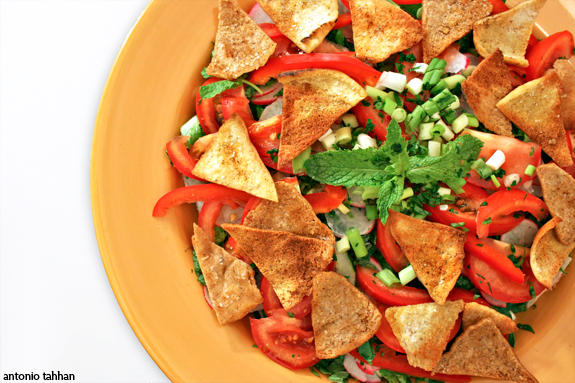
Your food always looks so fresh and vibrant. They do say the Middle Eastern diet is so healthy, right? I think I might give this one a go. Just looking at it is hitting the spot.
Thank you for sharing this recipe!!! I fell in love with fattoush in a middle eastern restaurant in Greece (which quickly became a favorite restaurant of ours all because of this salad!) and have been wanting to replicate it back home ever since…hooray! 🙂
Does this taste as pretty as your pictures?
Is that a Fattoush! or did you just sneeze! I love the word and the salad, of course!
Fattoush is my all-time favorite salad. It’s so good. Yours is beautiful. Great pictures. I do my bread, like you, in the oven. I’m craving this now.
Tony
Beautiful post, as always. I just want to mention that one ingredient that is essential to fattoosh is purslane or bakleh or mache in French. My friend grows it in her yard here in Texas next to her molookhiyeh. I buy it at the middle-eastern stores or mexican stores.
Joumana, you are absolutely right. I tried looking for purslane, but had no luck at my local market. I will add a note to the recipe – thanks for pointing that out!
MMmmm looks delightful and I have most of those ingredients in my fridge. This is going to be lunch tomorrow.
hi
i like your post
one day am going to do this famaous eastern salad
looks so delicious thanks for sharing
Touria
I adore fattoush!!! You’re right, it’s rustic appeal is undeniable and comforting! and it all about those pita shards on top! They always stab my mouth because I eat it so quickly… but it’s worth the pain!
I LOVE a good, garlicky fattoush! Thanks for posting this great recipe.
It was my first visit to your blog while I was looking for a tabbouleh image for my daughter Christina’s school project. Great job!
Finally I find real fattouche recipe the way we do it in Lebanon. You can also add pomegranade syrup *debes remmen* for those who know it!
I was surfing fattoush recipes, but want to compliment you on your blog layout. It’s very well done. I’ll probably be posting about my fattoush soon. Thank you for your inspiraton.
Hi, I just discovered your blog last night when I couldn’t sleep and spent hours drooling over your food. I went to order sumac from Amazon and was wondering what to order? They had several different types. Is it ground sumac that I need for this recipe? Also can you recommend a brand for the sumac, and orange blossom water? Thanks, Mary
PS. Just subscribed to your blog too! Mary
Hi Mary! Thank you for the comment. Yes, ground sumac is what you want to get. I use Ziyad brand for sumac and Cortas brand for orange blossom water. If you can’t find those brands just make sure to read the ingredient list to make sure there isn’t anything strange in there. I hope this helps!